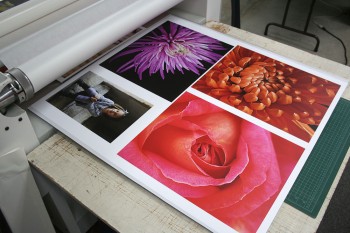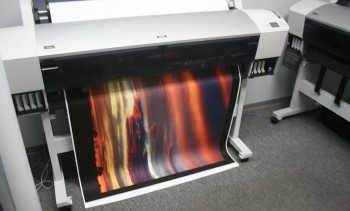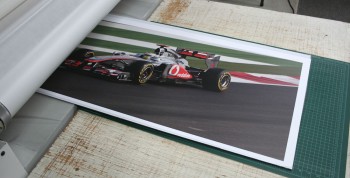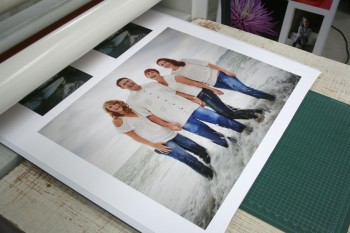 In a previous post, we profiled Keith Fabry Inc., a traditional reprographics company that embraced digital and responded to market demand accordingly. In the same vein, but from a different traditional path, Cali Color in Sacramento also embraced digital technology and its market response was similarly successful.
In a previous post, we profiled Keith Fabry Inc., a traditional reprographics company that embraced digital and responded to market demand accordingly. In the same vein, but from a different traditional path, Cali Color in Sacramento also embraced digital technology and its market response was similarly successful.
Where Keith Fabry Inc. gravitated toward more commercial point of purchase and corporate work, Cali Color explored the niches that made the most sense based on its experience and expertise. The commonality between the two, beyond large-format digital inkjet printing, is a savvy sense of customer awareness. Both understood and continue to understand demand and what, exactly, their respective markets demand.
Cali Color always had a handle on where its markets were headed, which is why the evolution from chemical process to digital process was relatively smooth and seamless. In short, Cali Color listens to its customers, anticipating demand so that its supply in the demand-and-supply equation is a perfect match.
While all this may be common sense, particularly in hindsight, as many similar companies found out in those revolutionary emerging-digital ’90s, it was difficult to see the forest for the trees, to repeat a cliché. Cali Color not only saw the forest, but the surrounding countryside as well.
 As Cali Color’s owner, Patrick O’Kane, explains: “In the early ’90s we got into digital because designers were making the transition from traditional mock-up to computer mock-up. They didn’t have any way to proof the images they were doing on the computer because there were no desktop digital printers at that time. We invested a lot of money in a Canon color copier and a Fiery controller, which allowed us to hook the computers to the color copier to output.”
As Cali Color’s owner, Patrick O’Kane, explains: “In the early ’90s we got into digital because designers were making the transition from traditional mock-up to computer mock-up. They didn’t have any way to proof the images they were doing on the computer because there were no desktop digital printers at that time. We invested a lot of money in a Canon color copier and a Fiery controller, which allowed us to hook the computers to the color copier to output.”
Though Cali Color made the move, it wasn’t easy. Matching Pantone colors with a toner-based, four-color printer was quite challenging, to say the least, but Cali Color made it work. Cali Color then moved to wide format with the acquisition of a 36-inch Encad NovaJet Pro to better serve those same designers. Cali Color had not yet purposed the printer for photographic and fine art reproduction since everything was still transparency-based. “We thought it was a great thing, but looking back it had a dot pattern the size of golf ball dimples,” says O’Kane.
Once digital cameras arrived on the scene, the possibilities for digital printing arrived as well. Cali Color, as O’Kane puts it, took a step back and evaluated their business and the landscape around it, plunging into inkjet photo reproduction with an Epson 9600.
 “We had the option to go inkjet or LightJet. The reason we decided to go inkjet was the initial cost of getting into the technology and because there were a lot of substrates available that we could offer our customers that we couldn’t with LightJet,” explains O’Kane. “We offered the entire giclee process and that took off quite quickly; a lot of people were looking for alternatives and the quality was much better than any offset processes available.”
“We had the option to go inkjet or LightJet. The reason we decided to go inkjet was the initial cost of getting into the technology and because there were a lot of substrates available that we could offer our customers that we couldn’t with LightJet,” explains O’Kane. “We offered the entire giclee process and that took off quite quickly; a lot of people were looking for alternatives and the quality was much better than any offset processes available.”
O’Kane says that since that time, Cali Color shut down its negative development processes and stopped doing traditional photographic printing and E6, becoming fully digital about three years ago. Cali Color’s earlier assessment at the digital crossroads proved prophetic as the versatility of inkjet ensured a satisfied and secure market.
“With all the materials LexJet was coming out with and improving, it gave our customers many different options. Now we offer most everything LexJet has to offer in the Sunset line. We found that our volume increased, so we’ve built a very nice niche in the fine art market. We also do a fair amount of trade show graphics, which has gotten us into other substrates like LexJet’s Water-Resistant Satin Cloth and cold PSA laminates,” says O’Kane. “What we’ve found, even in this economy, is that our client base is actually getting wider, including other states and the Bay Area. We’ve built a reputation based on quality. We’ve combined our equipment and our darkroom techniques from years ago, transferring those techniques for use on the computer.”
O’Kane says Cali Color prints a lot of canvas, from limited editions and custom gallery wraps to large décor jobs. The keys are consistency, economy and value-added service, he says, to be competitive in this market.
 “When it comes to a price point, LexJet’s Sunset canvases are great; they’re perfect for bidding on larger jobs, and I’m confident that the material we’re printing on will look great for years to come,” says O’Kane. “And, the Sunset Coatings are the best products I’ve seen in the way of protecting canvas prints… ever. I was using another coating, but it had to be diluted with distilled water and the dilution varied depending on the time of year I was doing it. I ruined more prints than I save. The Sunset product is ready to use out of the can and it doesn’t matter what humidity or temperature I’m dealing with. It’s an incredible product.”
“When it comes to a price point, LexJet’s Sunset canvases are great; they’re perfect for bidding on larger jobs, and I’m confident that the material we’re printing on will look great for years to come,” says O’Kane. “And, the Sunset Coatings are the best products I’ve seen in the way of protecting canvas prints… ever. I was using another coating, but it had to be diluted with distilled water and the dilution varied depending on the time of year I was doing it. I ruined more prints than I save. The Sunset product is ready to use out of the can and it doesn’t matter what humidity or temperature I’m dealing with. It’s an incredible product.”
O’Kane says his favorite print media for fine art and photography, aside from canvas, are Sunset Textured Fine Art and Sunset Hot Press Rag. “Our clients love those papers,” he says. “They’re consistent from batch to batch so I don’t have to worry about printing the same image six months down the road and having an issue with matching texture or anything else.”
For bin prints that people buy off the shelf from the artists and frame themselves, O’Kane uses LexJet’s Premium Archival Matte. “The fine art papers are generally reserved for limited editions, but if they’re selling prints that people can leaf through a bin to buy, Premium Archival Matte is a lot better paper for that since it’s less expensive. It also behaves a lot better than other matte papers I’ve used in that weight, and it’s archival.”
It’s all about options, and Cali Color makes sure its customers have plenty of them, whether it’s a large décor project or a laminated trade show graphic. It’s also about taking time to educate customers about those options, the thinking behind choosing materials and the printing process itself.
“We take time with our customers. The one thing digital has done it has made the photographer a darkroom technician. Some like it and some don’t. Some people have a handle on color, and some don’t. So, when we get a file from a customer, we take time to look at it. If we see deficiencies in that file – color, density, size, enough pixels to do the size they want – we’ll stop and talk to the customer to let them know our concerns,” says O’Kane. “I arrange a time with new customers to come in and we go through each individual file so we can show them if we make changes what the images will look like and how I feel it will be better. Back in the day when we were doing traditional processes, that’s what we did and made the best possible print we could by altering it – changing color density and burning and dodging.”
In other words, Cali Color is an open book to its clients. O’Kane shares information on how they calibrate their equipment, offer tutorials on color management and file preparation and gives talks to art and photography groups.
“I don’t think there are any huge trade secrets, so the more information I can give my customer, the more predictable the results are every time I get a file from them. It makes a difference, and it really doesn’t take that long,” says O’Kane.

